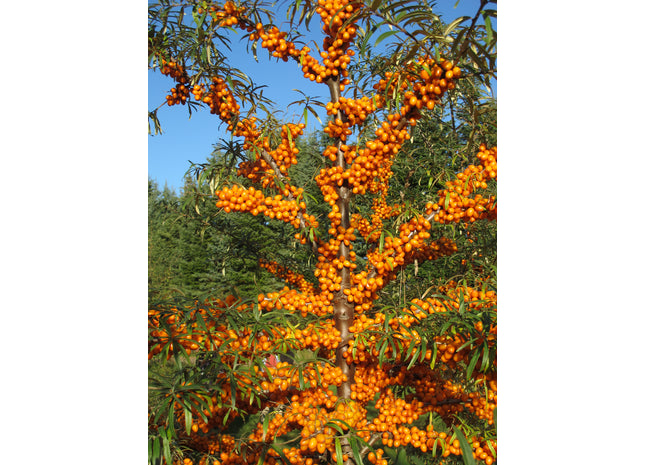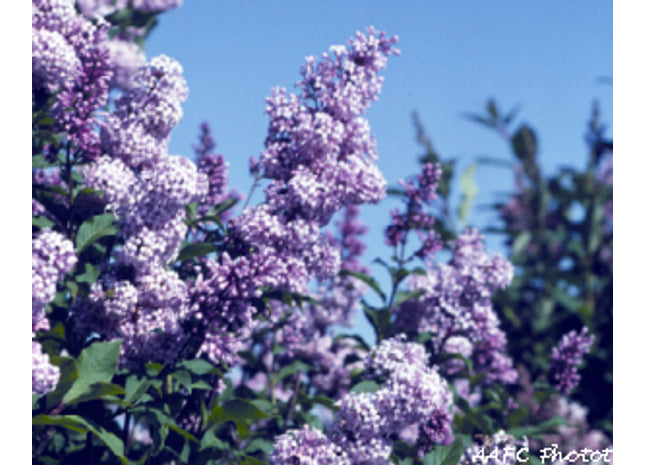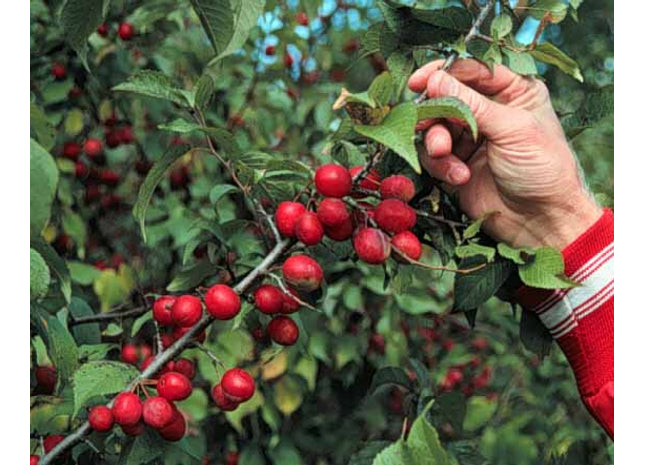Shrub & Berry Seeds

AgroForestry Solutions Saskatoon Berry Seed
Latin Name: Amelanchier alnifolia DESCRIPTION Family: Rosaceae Native Range: Native to the Canadian prairies. Seed Source: Natural stand near Jansen Lake, Saskatchewan. Height and Spread: 3m x 2m (5 years) Overview: This saskatoon berry seed strain is a bountiful berry producer. These bushes have been an excellent source of berries since the 1950’s. It is characterized by reliable berry production of flavourful medium-sized berries. This strain is adapted to a wide range of growing conditions. Fruit: Berry-like pomes up to 1.0 cm in diameter containing a single seed. Average number of seeds/packet: 600 SEED TREATMENT / SOWING Stratification: Pre-soak seed for 24 hours then stratify in moist sand (10% moisture) for 90-120 days at 5°C. Ideal sowing time: Non-pretreated seed outdoors in late September (will germinate the following spring) or stratified seed in spring. Sowing instructions: Outdoors - sow 1.0 to 1.5 cm deep, 50 seeds/meter; Greenhouse - sow 3 seeds per cell. Growing conditions: Saskatoon berry grows on a wide variety of soils but favors moist, loamy soils with a pH of 5.0 to 8.0. It is shade tolerant but prefers a sunny exposure. AGROFORESTRY VALUE Saskatoon berry is used in shelterbelts, Ecobuffers, and wildlife habitat plantings. The dense roots and rhizomes of Saskatoon make it useful for soil stabilization and erosion control on moist sites including streambanks. It provides good food and cover for birds plus small and large mammals. The berries are highly edible and are a prized fruit-producing plant in the home garden or commercial orchard.
$20.00 - $25.00

AgroForestry Solutions 'Ross' Caragana Seed
Latin Name: Caragana arborescens DESCRIPTION Family: Leguminosae Native Range: Europe and Asia Seed Source: Seed production orchard near Indian Head Saskatchewan Height and Spread (25 years): 6m x 3m Overview: An introduced shrub growing to six meters high. The 'Ross' seed strain was selected for its outstanding cold and drought hardiness. First introduced to Canada in the late 1800s, it became the number one species in western Canada planted for soil erosion control. It is a legume and fixes nitrogen. The 'Ross' seed strain is named in honour of Norman MacKenzie Ross who pioneered shelterbelt tree planting in the Canadian Prairies. Caragana is an extremely hardy and vigorous shrub that is well adapted to the prairies. This seed strain was first introduced from Russia by Mennonite settlers to Manitoba in the late 1800s. From then on it has been the widely used for shelterbelt planting across the entire prairie region. Caragana belongs to the legume family and fixes its own nitrogen. This means it will grow equally well in low nutrient and fertile soils. Under prairie conditions and with good care, ‘Ross’ caragana can reach a height of six meters (18 feet) in about 10 years. Caragana is meant to be used in the southern prairies where moisture and soil conditions limit the variety of shrub species that grow well. It should never be planted in or near a forest environment, once established in the forest it can spread quickly and be difficult to control or eradicate. Fruit: Dark brown linear pods 3 to 5 cm long. Average number of seeds/packet: 200 SEED TREATMENT / SOWING Stratification: Soak seeds for 24 hours in water at room temperature. Ideal sowing time: Spring Sowing instructions: Sow 2 cm deep, 50 seeds/meter; Greenhouse - sow 3 seeds per cell. Prior to sowing, soak the seed for about two days in fresh water at room temperature (change water once to ensure freshness). If you have access to a legume inoculant, lightly coat the seed with it prior to sowing. The inoculant will help to activate the nitrogen fixing ability of the caragana sooner. Sow in rows the same as radish or any similar garden seed. An ordinary garden seeder will handle this seed nicely. Sow the seed at a depth of 3/4 to 1 inch, never more than 1 1/2 inches with 12 to 18 seeds to the foot. Fall sowing seed generally gives the best results when sown from October 1 to just before freeze-up. If sown in the spring, get the seed in just as early as possible, and if the soil freezes again after sowing, so much the better. Leave enough space for cultivation between the rows. The seedlings should average from 10 inches to 18 inches the first season, which is a good size for shelterbelt planting. Growing conditions: Best growth on well-drained light and medium-textured soils. Fertilization is not required. Will tolerate slightly saline conditions. For establishment of shelterbelts, planting of seedlings will in most cases produce the best results, they can be started from seed; providing the ground is well worked and free of weeds. Crop land can be weedy which will quickly choke out young emerging seedlings before are established. Whether started from seed or seedlings, it is necessary to keep the soil well cultivated on both sides and in the row for three or four years. This can be done quite conveniently with a small cultivator or disc. As the caragana grows, the cultivated strip will need to be widened. Never sow or plant caragana in a low spot where water may lie for even a short time in spring. The plants will likely die under wet conditions. For a caragana hedge plant 2-3 deeds 18 inches (45cm) apart ¾ to 1 inch deep in mid May. AGROFORESTRY VALUE Excellent for farm or field shelterbelts or landscape hedges where a tough hardy plant is needed. 'Ross' caragana is extremely drought tolerant that forms a dense hedge useful as a windbreak for snow and wind management.
$20.00 - $25.00

AgroForestry Solutions 'Indian-Summer' Seabuckthorn Seed
Latin Name: Hippophae rhamnoides ssp. Mongolica DESCRIPTION Family: Elaeagnaceae Native Range: Europe and Asia Seed Source: Seed production orchard near Indian Head, Saskatchewan. Height and Spread: 4m x 2m (10 years) Overview: A wonderful plant recognized by many as one of the most nutritional berries in the plant kingdom. A nitrogen fixer, the 'Indian -Summer' seed strain is extremely hardy and adapted to low quality, droughty soils. Seeds produce a mixture of male and female plants. Fruits: An orange drupe-like achene 3 to 6mm long. Berries remain on shrubs over winter. Average number of seeds/packet: 240 SEED TREATMENT / SOWING Stratification: Soak the seeds for 24 hours, then stratify in moist sand (10 percent moisture) for 60 days at 5C. No treatment needed if down outdoors in late September (Germination occurs the following spring). Ideal sowing time: Spring Sowing instructions: Outdoors - sow 1 cm deep and 50 seeds/meter; Greenhouse- sow 3 seeds per cell. Growing conditions: 'Indian-Summer' grows well on a variety of soils, requires full sunlight, does not tolerate shade. AGROFORESTRY VALUE 'Indian-Summer' is an excellent seed strain for farm or field shelterbelts, intercropping, reclamation, and wildlife habitat plantings. The seed strain was developed specifically for agroforestry, stabilizes eroding soil, contributes nitrogen, and provides wildlife valuable cover. It is often used as a pollinator row in seabuckthorn orchards. One of the most versatile agroforestry plants. Harvest Seabuckthorn berries Your browser does not support our video Your browser does not support our video
$20.00 - $25.00

AgroForestry Solutions 'Charlie Edwards' Villosa Lilac Seed
Latin Name: Syringa villosa DESCRIPTION Family: Oleaceae Native Range: Northeastern China Seed Source: Improved seed strain, seed production orchard near Indian Head Saskatchewan. Height and Spread: 4m x 3m Overview: The seed strain was developed for tree planting in the Canadian prairies. It is a composite of parent trees from selected lilac shelterbelts. It is a medium-large, hardy shrub with an oval-shaped crown. It has basal sprouts but does not spread by suckers. It was named in honour of Charlie Edwards assistant superintendent of the Indian Head Forest Nursery Station from 1909 to 1950. Fruit: Seed ripens in a capsule in late summer. Average number of seeds/packet: 450 SEED TREATMENT / SOWING Stratification: Pre-soak seed for 24 hours then stratify in moist sand (10 percent moisture) for 60 days at 5°C. Ideal sowing time: Non-pretreated seed outdoors in September (will germinate the following spring) or stratified seed in spring. Sowing instructions: Sow 1.5 cm deep, 50 seeds/meter; Greenhouse - sow 3 seeds per cell. Growing conditions: The 'Charlie Edwards' seed strain is adapted to most soils and is hardy to zone 2. AGROFORESTRY VALUE 'Charlie Edwards' villosa lilac is used for shelterbelt and hedge planting in field and farmyard shelterbelts. The dense growth habit is well suited for providing wind and snow protection. It provides excellent cover and habitat for songbirds and small mammals. Lilac species are rated excellent for pollen availability. The attractive white/lavender blooms add fragrance and beauty to plantings.
$20.00 - $25.00

AgroForestry Solutions 'Ralph Dunlop' Silver Buffaloberry Seed
Latin Name: Shepherdia argentea DESCRIPTION Family: Elaeagnaceae Native Range: Canadian Prairie Provinces, United States Northern Great Plains. Seed Source: Natural stand near Indian Head Saskatchewan. Height and Spread: 4m x 2m (10 years). Overview: The 'Ralph Dunlop' seed strain was developed for tree planting in the Canadian prairies. This strain originates from a natural stand of buffaloberry with above average berry size. The strain is named in honour of Ralph Dunlop a tree planting technician at the Indian Head Forest Nursery Station from 1924 to 1961. Buffaloberry is a wonderful plant recognized by many as one of the most nutritional berries in the plant kingdom. Seeds produce a mix of male and female plants. Fruits: A red drupe-like achene 3 to 6mm long. Average number of seeds/packet: 750 SEED TREATMENT / SOWING Stratification: Stratify in moist sand (10% moisture) for 90 days at 5°C. Ideal sowing time: Non-pretreated seed outdoors in late September, Stratified seed in spring Sowing instructions: Outdoors - Sow 1 cm deep and 50 seeds/meter; Greenhouse - sow 3 seeds per cell 1 cm deep. Growing conditions: The seed strain requires full sunlight and does not tolerate shade. It is a nitrogen fixer, extremely hardy, and adapted to low-quality, dry soils. Excellent for the farmstead, intercropping, reclamation, Eco-Buffers, and wildlife habitat plantings. AGROFORESTRY VALUE 'Ralph Dunlop' Buffaloberry is an excellent choice for farmsteads, intercropping, reclamation, and wildlife habitat plantings. This seed strain was bred and developed specifically for temperate agroforestry. Buffaloberry stabilizes eroding soil, contributes nitrogen, and provides wildlife valuable cover, particularly upland game birds. Female plants can be used for fruit production. Your browser does not support our video
$20.00 - $25.00

AgroForestry Solutions Sour Cherry Seed
Latin Name: Prunus x eminens DESCRIPTION Family: Rosaceae Native Range: Eurasia Seed Source: 'Carmine Jewel' sour cherry orchard near Lumsden, Saskatchewan Height and Spread: 2m x 2m Overview: In the 1970s the University of Saskatchewan imported and began evaluating P. cerasus x P. fruticosa hybrids from the Siberian Botanical Garden. From this population, the Carmine Jewel cultivar was selected. This seed strain is an open-pollinated seed collected from Carmine Jewel plants. Fruit: A single-seeded small cherry. Average number of seeds/packet: 100 SEED TREATMENT / SOWING Stratification: 90 days cold stratification at 5C Ideal Sowing Time: Non-stratified seed outdoors in July (will germinate the following spring) or stratified seed in late May. Sowing Instructions: Outdoors - sow 2.0 cm deep, 50 seeds per meter; Greenhouse - sow 3 seeds per cell. Growing Conditions: Grows best on light to medium soils in full sunlight. AGROFORESTRY VALUE Use in Ecobuffers and wildlife habitat plantings. Berries are relished by many songbirds and shrubs provide nesting and roosting cover. The cherries can be preserved as jelly or dried.
$20.00

AgroForestry Solutions 'Midnight' Choke Cherry Seed
Latin Name: Prunus virginiana DESCRIPTION Family: Rosaceae Native Range: Canada and the Northern United States Seed Source: Natural stand growing near Jansen Lake, Saskatchewan. Height and Spread: 7m x 4m Overview: 'Midnight' Choke cherry is an excellent choice for agroforestry planting in cold temperate regions. This seed strain was selected many years ago by a local farmer because of its consistent production of large yields of black cherries. Fruits: Black fruit borne in clusters, 8-12 mm across. Average number of seeds/packet: 150 SEED TREATMENT / SOWING Stratification: Stratify in moist sand (10 percent moisture) for 30 days at room temperature (20°C) followed by 120 days at 5°C. Ideal sowing time: Non-pretreated seed outdoors in July (will germinate the following spring) or stratified seed in spring. Sowing instructions: Outdoor seedbed - Sow 2 cm deep and 50 seeds/meter; Greenhouse - sow 3 seeds per cell 1 cm deep. Growing conditions: Choke cherry will thrive under just about every condition imaginable, except for heavy shade. AGROFORESTRY VALUE 'Midnight' choke cherry is an excellent seed strain for field and farmstead shelterbelts, intercropping, reclamation, and wildlife habitat plantings. All plants produce fruit that can be used for berry harvest. The fruit is astringent but edible and makes excellent juice, syrup, or jelly.
$20.00 - $25.00

AgroForestry Solutions Mongolian Cherry Seed
Latin Name: Prunus fruticosa DESCRIPTION Family: Rosaceae Native Range: An introduced shrub from Asia. Seed Source: Seed production orchard near Indian Head, Saskatchewan. Height and Spread: 2m x 2m (5 years) Overview: The Mongolian cherry seed is ultra-hardy and adapted to cold temperate climates. It was developed specifically for agroforestry planting. Mongolian cherry produces high yields of edible tart cherries. The fruit is much sweeter if cooked or dried. Fruits: A round single-seeded purplish-red cherry, 1.5 cm in diameter. Average number of seeds/packet: 75 SEED TREATMENT / SOWING Stratification: Stratify in moist sand (10 percent moisture) for 120 days at 5oC. Ideal sowing time: Non-pretreated seed outdoors in late September (will germinate the following spring) or stratified seed in spring. Sowing instructions: Sow 2.0 cm deep, 50 seeds/meter; Greenhouse - sow 3 seeds per cell. Growing conditions: ’Brilliant’ Mongolian cherry grows well on medium-textured soils with soil pH 7.0 to 8.0. Agroforestry Value Mongolian Cherry is used in farmstead and field shelterbelts, Eco-Buffers, wildlife habitat, and fruit orchard plantings. Many song and game birds utilize this shrub for food and habitat. The cherries can be eaten fresh, preserved as jelly, or dried.
$20.00

AgroForestry Solutions Highbush Cranberry Seed
Latin Name: Viburnum trilobum DESCRIPTION Family: Caprifoliaceae Native Range: Southern Canada and the northern United States west to Eastern Saskatchewan. Seed Source: A natural stand near Chelan, Saskatchewan. Height and Spread: 4m x 2m (10 years) Overview: The seed strain has proven to be well adapted for tree planting in the Canadian prairies. It is a composite of selected parent trees in natural stands. Fruits: Red drupe, 8-12 mm long with thin sour-sweet edible flesh. Average number of seeds/packet: 300 SEED TREATMENT / SOWING Stratification: Soak seed 72 hours then stratify in moist sand (10 percent moisture) for 140 days at 20⁰C. When germinations starts to occur in bag, sow into a flat of peat moss in warm conditions until seeds sprout. Transplant sprouted seed to containers. Ideal sowing time: Non-treated seed in summer (will germinate the following spring) or stratified seed in spring. Sowing instructions: Outdoor seedbed - Sow 2.0 cm deep and 75 seeds/meter; Greenhouse - sow 3 seeds per cell 1 cm deep. Growing conditions: Grows in full sunlight and shade. It is extremely hardy and prefers moist soils. It will colonize a site with root suckers. AGROFORESTRY VALUE Highbush cranberry is an excellent choice for windbreaks, EcoBuffers, and wildlife habitat plantings. This seed strain was developed specifically for agroforestry planting. Highbush cranberry provides wildlife valuable cover. It produces nutritious sour-sweet berries.
$20.00 - $25.00

AgroForestry Solutions 'Reay' Nannyberry Seed
Latin Name: Viburnum lentago DESCRIPTION Family: Caprifoliaceae Native Range: Southern Canada and the northern United States west to Eastern Saskatchewan. Seed Source: Natural stand growing near Thunderhill, Manitoba. Height and Spread: 4m x 2m (10 years) Overview: The ‘Reay’ seed strain has proven to be well adapted for tree planting in the Canadian prairies. It is a composite of selected parent trees from natural stands. The seed strain is named in honour of John Reay, a tree planting inspector at the Forest Nursery Station from 1914 to 1924. Fruits: Bluish-black drupe, 8-12 mm long with thin sweet edible flesh. Average number of seeds/packet: 150 SEED TREATMENT / SOWING Stratification: Pre-soak seed for 24 hours then stratify in moist sand (10 % moisture) for 180 days at 20oC followed by 90 days at 5oC. Ideal sowing time: Non-treated seed in summer (will germinate the following spring) or stratified seed in spring. Sowing instructions: Outdoor seedbed - Sow 1.5 cm deep and 50 seeds/meter; Greenhouse - sow 2 seeds per cell 1 cm deep. Growing conditions: Grows in full sunlight and shade. It is extremely hardy and prefers moist soils. It will colonize a site with root suckers. AGROFORESTRY VALUE 'Reay' nannyberry is an excellent choice for windbreaks, EcoBuffers, and wildlife habitat plantings. This seed strain was developed specifically for agroforestry planting. Nannyberry stabilizes eroding soil and provides wildlife valuable cover. It produces nutritious sweet berries.
$20.00 - $25.00

AgroForestry Solutions 'Hudson Bay' American Plum Seed
Latin Name: Prunus americana DESCRIPTION Family: Rosaceae Native Range: Native to southern Canada from Saskatchewan in the west to Quebec Seed Source: Seed production stand near Indian Head, Saskatchewan. Height and Spread: 5m x 3m (5 years) Overview: The 'Hudson Bay' American plum seed strain is adapted to cold temperate dry climates. This strain comes from a shelterbelt growing near Hudson Bay Saskatchewan. A pioneer plant quickly colonizing sites this seed strain produces bright red edible plums. Wild plum is a shrub or small tree 3-8 m tall, and usually found growing as dense thickets. Fruits: Reddish-purple oval plums 2.0-2.5 cm long containing one seed. Average number of seeds per packet - 50 SEED TREATMENT / SOWING Stratification: Pre-soak seed for 24 hours then stratify in moist sand (10 percent moisture) for 180 days at 5°C. Ideal sowing time: Non-pretreated seed outdoors in early September (will germinate the following spring) or stratified seed in spring. Sowing instructions: Outdoors - sow 2.0 cm deep, 50 seeds/meter; Greenhouse - sow 3 seeds per cell. Growing conditions: American plum grows well on a wide range of soils. As a colonizer, it will flourish on most disturbed sites. It prefers full sunlight and is considered somewhat drought tolerant and cold hardy. AGROFORESTRY VALUE American plums make good wildlife habitat and are effective in erosion control because their roots hold the soil. Their thorny branches catch tumbleweeds, leaves, and other plant materials, which, when windstorms occur during times of drought, provide an effective means of slowing wind erosion of soil.
$25.00

AgroForestry Solutions 'Stevenson' Red-Osier Dogwood Seed
Latin Name: Cornus stolonifera DESCRIPTION Family: Caprifoliaceae Native Range: Native to most regions of Canada and the northern United States. Seed Source: Natural stand near Lake Margaurite, Saskatchewan. Height and Spread: 3m x 2m (5 years). Overview: 'Stevenson' red-osier dogwood is a medium shrub that is hardy and well adapted to northern temperate growing conditions. The seeds train is named in honour of A.P. Stevenson, renowned horticulturist and a tree planting technician at the Dominion Forest Nursery Station from 1901 to 1922. Fruit: Berry-like drupe 0.5 cm in diameter containing a single seed. Average number of seeds/packet: 200 SEED TREATMENT / SOWING Stratification: Stratify in moist sand (10% moisture) for 70 days at 5°C. Ideal sowing time: Non-pretreated seed outdoors in late September (will germinate the following spring) or stratified seed in spring. Sowing instructions: Sow 2.0 cm deep, 50 seeds/meter; Greenhouse - sow 3 seeds per cell. Growing conditions: 'Stevenson' red-osier dogwood grows on a wide variety of soils but favors moist, loamy soils re and a pH of 5.0 to 8.0. It is shade tolerant but prefers a sunny exposure. AGROFORESTRY VALUE 'Stevenson' red-osier dogwood is suited for shelterbelts, Eco-Buffers, and wildlife habitat plantings. A dense root system and rhizomes make it useful for soil stabilization and erosion control on moist sites including streambanks. It provides good food and cover for birds plus small and large mammals. The berries are edible.
$25.00












